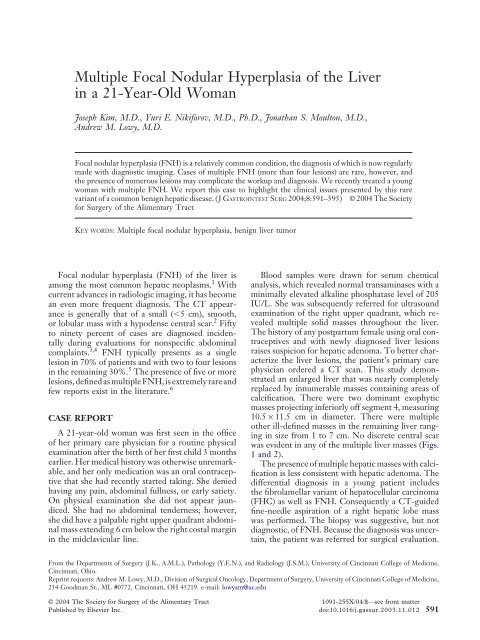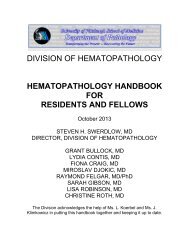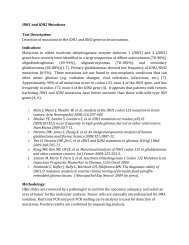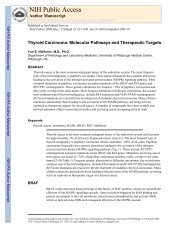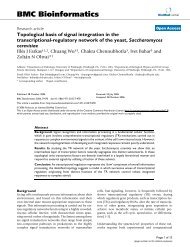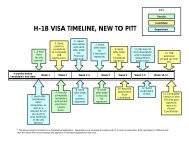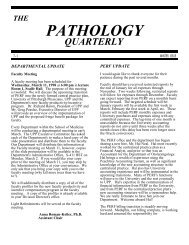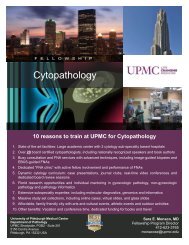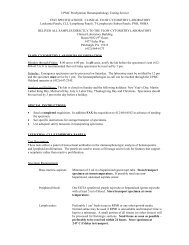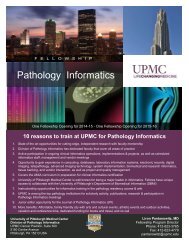Multiple Focal Nodular Hyperplasia of the Liver in - Department of ...
Multiple Focal Nodular Hyperplasia of the Liver in - Department of ...
Multiple Focal Nodular Hyperplasia of the Liver in - Department of ...
You also want an ePaper? Increase the reach of your titles
YUMPU automatically turns print PDFs into web optimized ePapers that Google loves.
<strong>Multiple</strong> <strong>Focal</strong> <strong>Nodular</strong> <strong>Hyperplasia</strong> <strong>of</strong> <strong>the</strong> <strong>Liver</strong><br />
<strong>in</strong> a 21-Year-Old Woman<br />
Joseph Kim, M.D., Yuri E. Nikiforov, M.D., Ph.D., Jonathan S. Moulton, M.D.,<br />
Andrew M. Lowy, M.D.<br />
<strong>Focal</strong> nodular hyperplasia (FNH) is a relatively common condition, <strong>the</strong> diagnosis <strong>of</strong> which is now regularly<br />
made with diagnostic imag<strong>in</strong>g. Cases <strong>of</strong> multiple FNH (more than four lesions) are rare, however, and<br />
<strong>the</strong> presence <strong>of</strong> numerous lesions may complicate <strong>the</strong> workup and diagnosis. We recently treated a young<br />
woman with multiple FNH. We report this case to highlight <strong>the</strong> cl<strong>in</strong>ical issues presented by this rare<br />
variant <strong>of</strong> a common benign hepatic disease. (J GASTROINTEST SURG 2004;8:591–595) 2004 The Society<br />
for Surgery <strong>of</strong> <strong>the</strong> Alimentary Tract<br />
KEY WORDS: <strong>Multiple</strong> focal nodular hyperplasia, benign liver tumor<br />
<strong>Focal</strong> nodular hyperplasia (FNH) <strong>of</strong> <strong>the</strong> liver is<br />
among <strong>the</strong> most common hepatic neoplasms. 1 With<br />
current advances <strong>in</strong> radiologic imag<strong>in</strong>g, it has become<br />
an even more frequent diagnosis. The CT appearance<br />
is generally that <strong>of</strong> a small (5 cm), smooth,<br />
or lobular mass with a hypodense central scar. 2 Fifty<br />
to n<strong>in</strong>ety percent <strong>of</strong> cases are diagnosed <strong>in</strong>cidentally<br />
dur<strong>in</strong>g evaluations for nonspecific abdom<strong>in</strong>al<br />
compla<strong>in</strong>ts. 3,4 FNH typically presents as a s<strong>in</strong>gle<br />
lesion <strong>in</strong> 70% <strong>of</strong> patients and with two to four lesions<br />
<strong>in</strong> <strong>the</strong> rema<strong>in</strong><strong>in</strong>g 30%. 5 The presence <strong>of</strong> five or more<br />
lesions, def<strong>in</strong>ed as multiple FNH, is extremely rare and<br />
few reports exist <strong>in</strong> <strong>the</strong> literature. 6<br />
CASE REPORT<br />
A 21-year-old woman was first seen <strong>in</strong> <strong>the</strong> <strong>of</strong>fice<br />
<strong>of</strong> her primary care physician for a rout<strong>in</strong>e physical<br />
exam<strong>in</strong>ation after <strong>the</strong> birth <strong>of</strong> her first child 3 months<br />
earlier. Her medical history was o<strong>the</strong>rwise unremarkable,<br />
and her only medication was an oral contraceptive<br />
that she had recently started tak<strong>in</strong>g. She denied<br />
hav<strong>in</strong>g any pa<strong>in</strong>, abdom<strong>in</strong>al fullness, or early satiety.<br />
On physical exam<strong>in</strong>ation she did not appear jaundiced.<br />
She had no abdom<strong>in</strong>al tenderness; however,<br />
she did have a palpable right upper quadrant abdom<strong>in</strong>al<br />
mass extend<strong>in</strong>g 6 cm below <strong>the</strong> right costal marg<strong>in</strong><br />
<strong>in</strong> <strong>the</strong> midclavicular l<strong>in</strong>e.<br />
Blood samples were drawn for serum chemical<br />
analysis, which revealed normal transam<strong>in</strong>ases with a<br />
m<strong>in</strong>imally elevated alkal<strong>in</strong>e phosphatase level <strong>of</strong> 205<br />
IU/L. She was subsequently referred for ultrasound<br />
exam<strong>in</strong>ation <strong>of</strong> <strong>the</strong> right upper quadrant, which revealed<br />
multiple solid masses throughout <strong>the</strong> liver.<br />
The history <strong>of</strong> any postpartum female us<strong>in</strong>g oral contraceptives<br />
and with newly diagnosed liver lesions<br />
raises suspicion for hepatic adenoma. To better characterize<br />
<strong>the</strong> liver lesions, <strong>the</strong> patient’s primary care<br />
physician ordered a CT scan. This study demonstrated<br />
an enlarged liver that was nearly completely<br />
replaced by <strong>in</strong>numerable masses conta<strong>in</strong><strong>in</strong>g areas <strong>of</strong><br />
calcification. There were two dom<strong>in</strong>ant exophytic<br />
masses project<strong>in</strong>g <strong>in</strong>feriorly <strong>of</strong>f segment 4, measur<strong>in</strong>g<br />
10.5 × 11.5 cm <strong>in</strong> diameter. There were multiple<br />
o<strong>the</strong>r ill-def<strong>in</strong>ed masses <strong>in</strong> <strong>the</strong> rema<strong>in</strong><strong>in</strong>g liver rang<strong>in</strong>g<br />
<strong>in</strong> size from 1 to 7 cm. No discrete central scar<br />
was evident <strong>in</strong> any <strong>of</strong> <strong>the</strong> multiple liver masses (Figs.<br />
1 and 2).<br />
The presence <strong>of</strong> multiple hepatic masses with calcification<br />
is less consistent with hepatic adenoma. The<br />
differential diagnosis <strong>in</strong> a young patient <strong>in</strong>cludes<br />
<strong>the</strong> fibrolamellar variant <strong>of</strong> hepatocellular carc<strong>in</strong>oma<br />
(FHC) as well as FNH. Consequently a CT-guided<br />
f<strong>in</strong>e-needle aspiration <strong>of</strong> a right hepatic lobe mass<br />
was performed. The biopsy was suggestive, but not<br />
diagnostic, <strong>of</strong> FNH. Because <strong>the</strong> diagnosis was uncerta<strong>in</strong>,<br />
<strong>the</strong> patient was referred for surgical evaluation.<br />
From <strong>the</strong> <strong>Department</strong>s <strong>of</strong> Surgery (J.K., A.M.L.), Pathology (Y.E.N.), and Radiology (J.S.M.), University <strong>of</strong> C<strong>in</strong>c<strong>in</strong>nati College <strong>of</strong> Medic<strong>in</strong>e,<br />
C<strong>in</strong>c<strong>in</strong>nati, Ohio.<br />
Repr<strong>in</strong>t requests: Andrew M. Lowy, M.D., Division <strong>of</strong> Surgical Oncology, <strong>Department</strong> <strong>of</strong> Surgery, University <strong>of</strong> C<strong>in</strong>c<strong>in</strong>nati College <strong>of</strong> Medic<strong>in</strong>e,<br />
234 Goodman St., ML #0772, C<strong>in</strong>c<strong>in</strong>nati, OH 45219. e-mail: lowyam@uc.edu<br />
<br />
2004 The Society for Surgery <strong>of</strong> <strong>the</strong> Alimentary Tract<br />
1091-255X/04/$—see front matter<br />
Published by Elsevier Inc. doi:10.1016/j.gassur.2003.11.012 591
592 Kim et al.<br />
Journal <strong>of</strong><br />
Gastro<strong>in</strong>test<strong>in</strong>al Surgery<br />
Fig. 1. Arterial phase CT imag<strong>in</strong>g <strong>of</strong> multiple FNH. Arterial phase images through <strong>the</strong> superior (A)<br />
and <strong>in</strong>ferior (B) liver. A, There is a heterogeneous mass <strong>in</strong> <strong>the</strong> left lateral segment that is not hypervascular.<br />
The right lobe <strong>of</strong> <strong>the</strong> liver is atrophic. B, There is an exophytic mass project<strong>in</strong>g <strong>of</strong>f <strong>of</strong> <strong>the</strong> medial segment<br />
<strong>of</strong> <strong>the</strong> left lobe, which is heterogeneous and conta<strong>in</strong>s multiple punctate calcifications.<br />
After <strong>the</strong> patient’s history and results <strong>of</strong> radiologic<br />
imag<strong>in</strong>g studies were reviewed, surgical biopsy was<br />
recommended. The rationale for surgical biopsy was<br />
to obta<strong>in</strong> adequate tissue samples to establish a diagnosis<br />
with absolute certa<strong>in</strong>ty and to allow visual <strong>in</strong>spection<br />
<strong>of</strong> <strong>the</strong> multiple areas <strong>of</strong> <strong>in</strong>volvement.<br />
Fig. 2. Portal venous phase CT images <strong>of</strong> multiple FNH at multiple levels from superior to Inferior. A,<br />
There is a large heterogeneous mass <strong>in</strong> <strong>the</strong> left lateral segment, which is predom<strong>in</strong>antly hypodense to<br />
normal liver. The adjacent medial left and right lobes are diffusely heterogeneous, conta<strong>in</strong><strong>in</strong>g multiple<br />
hypodense lesions that are difficult to <strong>in</strong>dividually discrim<strong>in</strong>ate. B, Portal venous phase at <strong>the</strong> same level<br />
as <strong>in</strong> Fig. 1, A. The exophytic lateral left segment lesion (*) is aga<strong>in</strong> seen, appear<strong>in</strong>g more hypodense<br />
to liver. A smaller hypodense lesion (**) is seen next to <strong>the</strong> gallbladder. Small hyperdense foci (arrowheads)<br />
represent dilated hepatic ve<strong>in</strong>s. C, The <strong>in</strong>ferior portion <strong>of</strong> <strong>the</strong> exophytic left lateral segment lesion is<br />
seen (*). Ano<strong>the</strong>r small left medial hypodense lesion (**) is evident, as are dilated hepatic ve<strong>in</strong>s (arrowhead).<br />
D, The second large exophytic segment IV lesion (*) is evident, appear<strong>in</strong>g more hypodense to liver with<br />
unchanged foci <strong>of</strong> calcification.
Vol. 8, No. 5<br />
2004 <strong>Multiple</strong> <strong>Focal</strong> <strong>Nodular</strong> <strong>Hyperplasia</strong> 593<br />
An exploratory laparoscopy was performed. Grossly<br />
<strong>the</strong> liver appeared to conta<strong>in</strong> multiple large solid<br />
tumors. Visually <strong>the</strong>y appeared discrete but similar<br />
<strong>in</strong> appearance to one ano<strong>the</strong>r. An area <strong>of</strong> <strong>the</strong> left<br />
lateral segment was selected for biopsy. A laparoscopic<br />
wedge resection was performed with ultrasonic<br />
shears (Harmonic Scalpel; Ethicon Endo-Surgery,<br />
C<strong>in</strong>c<strong>in</strong>nati, OH) and was sent <strong>of</strong>f for frozen-section<br />
pathologic analysis. Histologic exam<strong>in</strong>ation revealed<br />
a th<strong>in</strong> rim <strong>of</strong> normal liver parenchyma and a nonencapsulated<br />
lesion composed <strong>of</strong> sheets <strong>of</strong> benign-appear<strong>in</strong>g<br />
hepatocytes surrounded by fibrotic bands<br />
(Fig. 3). The fibrotic bands conta<strong>in</strong>ed th<strong>in</strong>-walled<br />
and thick-walled blood vessels and focal bile ductular<br />
proliferation located at <strong>the</strong> <strong>in</strong>terface between fibrotic<br />
areas and hepatocytes. However, <strong>the</strong>re were no identifiable<br />
<strong>in</strong>terlobular bile ducts. The hepatocytes <strong>in</strong> <strong>the</strong><br />
lesion demonstrated severe predom<strong>in</strong>antly macrovesicular<br />
steatosis (which was observed <strong>in</strong> more than<br />
90% <strong>of</strong> hepatocytes), but no pleomorphism or cytologic<br />
atypia. These microscopic features were diagnostic<br />
<strong>of</strong> FNH.<br />
Once <strong>the</strong> diagnosis <strong>of</strong> FNH was returned, <strong>the</strong> operation<br />
was concluded. The f<strong>in</strong>al pathologic specimen<br />
revealed preservation <strong>of</strong> <strong>the</strong> reticul<strong>in</strong> network (as detected<br />
by a reticul<strong>in</strong> sta<strong>in</strong>) and a low mitotic <strong>in</strong>dex<br />
(1% by immunohistochemical analysis with MIB-<br />
1 antibody), which confirmed <strong>the</strong> benign orig<strong>in</strong> <strong>of</strong><br />
this lesion. The patient was discharged on postoperative<br />
day 1. In subsequent follow-up, <strong>the</strong> patient rema<strong>in</strong>s<br />
asymptomatic. Follow-up CT scann<strong>in</strong>g has<br />
revealed no change <strong>in</strong> <strong>the</strong> multiple FNH, now at 2<br />
years’ follow-up.<br />
DISCUSSION<br />
FNH is a benign tumor-like lesion characterized<br />
by a central fibrous scar with irradiat<strong>in</strong>g fibrous septa<br />
Fig. 3. Microscopic appearance <strong>of</strong> multiple FNH. Microscopic exam<strong>in</strong>ation <strong>of</strong> <strong>the</strong> surgical specimen<br />
revealed features <strong>of</strong> FNH <strong>in</strong>clud<strong>in</strong>g nodular appearance on <strong>the</strong> liver (A) and multiple fibrotic bands<br />
conta<strong>in</strong><strong>in</strong>g malformed blood vessels and focal chronic <strong>in</strong>flammation but no <strong>in</strong>terlobular bile ducts (B).<br />
An unusual microscopic feature <strong>in</strong> this case was an extensive predom<strong>in</strong>ant macrovesicular steatosis<br />
<strong>in</strong>volv<strong>in</strong>g hepatocytes <strong>in</strong> <strong>the</strong> lesion.
594 Kim et al.<br />
Journal <strong>of</strong><br />
Gastro<strong>in</strong>test<strong>in</strong>al Surgery<br />
that surround hyperplastic parenchymal nodules. The<br />
central scar conta<strong>in</strong>s an anomalous feed<strong>in</strong>g artery. 7,8<br />
The hepatocytes <strong>in</strong> <strong>the</strong> lesion are normal, and bile<br />
duct proliferation is usually prom<strong>in</strong>ent. 9,10 It is usually<br />
a stable lesion that does not enlarge over long periods<br />
<strong>of</strong> time. Rarely, it is complicated by growth, rupture,<br />
portal hypertension, hemorrhage, or necrosis. 11<br />
In this patient, <strong>the</strong> history and CT images mandated<br />
consideration <strong>of</strong> FNH, FHC, and hepatic adenoma <strong>in</strong><br />
<strong>the</strong> differential diagnosis. As compared to FNH, on CT<br />
imag<strong>in</strong>g, adenomas tend to be larger, more heterogeneous,<br />
may have hemorrhage, and lack a central scar.<br />
They generally have less arterial enhancement and<br />
may conta<strong>in</strong> fat. Fibrolamellar hepatocellular carc<strong>in</strong>oma<br />
tends to be large, have calcification, and be heterogeneous.<br />
It is also prone to hemorrhage and to<br />
have areas <strong>of</strong> necrosis. The lesions <strong>in</strong> this patient were<br />
large, heterogeneous, had little enhancement, and<br />
lacked a scar. Thus, on <strong>the</strong> basis <strong>of</strong> imag<strong>in</strong>g characteristics,<br />
<strong>the</strong> lesions <strong>in</strong> this patient were more consistent<br />
with adenoma or fibrolamellar hepatocellular carc<strong>in</strong>oma.<br />
As such, def<strong>in</strong>itive biopsy was <strong>in</strong>dicated.<br />
Histologically, adenoma and FHC can have similar<br />
characteristics to FNH. Adenoma is <strong>of</strong>ten composed<br />
<strong>of</strong> sheets <strong>of</strong> normal-appear<strong>in</strong>g hepatocytes without<br />
features <strong>of</strong> malignancy. There are few or no portal<br />
tracts or central ve<strong>in</strong>s, and bile ducts are absent. 12,13<br />
These features dist<strong>in</strong>guish adenoma from FNH.<br />
FHC may similarly be composed <strong>of</strong> sheets <strong>of</strong> hepatocytes.<br />
However, <strong>the</strong>se cells are dist<strong>in</strong>ctively plump<br />
and deeply eos<strong>in</strong>ophilic. Pale or hyal<strong>in</strong>e bodies <strong>in</strong> <strong>the</strong><br />
cytoplasm, prom<strong>in</strong>ent nucleoli, and rare mitoses are<br />
characteristic <strong>of</strong> FHC. 14<br />
The pathogenesis <strong>of</strong> FNH is unclear, but two predom<strong>in</strong>ant<br />
<strong>the</strong>ories exist. FNH may be a response to<br />
a preexist<strong>in</strong>g vascular abnormality. 8,15 The artery associated<br />
with <strong>the</strong> central scar is larger than normal<br />
and causes hyperperfusion <strong>in</strong> this region and/or arterialization<br />
<strong>of</strong> s<strong>in</strong>usoids, with result<strong>in</strong>g hyperplasia <strong>of</strong><br />
<strong>the</strong> surround<strong>in</strong>g parenchyma. Growth <strong>of</strong> surround<strong>in</strong>g<br />
hepatocytes stops when <strong>the</strong> s<strong>in</strong>usoids are compressed<br />
and vascular resistance <strong>in</strong>creases with slow<strong>in</strong>g <strong>of</strong> <strong>the</strong><br />
blood flow. 8 The second <strong>the</strong>ory relates to <strong>the</strong> use <strong>of</strong><br />
oral contraceptives. In contrast to adenoma, <strong>the</strong><br />
orig<strong>in</strong> <strong>of</strong> FNH has not been def<strong>in</strong>itively l<strong>in</strong>ked to<br />
estrogen, but based on isolated reports, it is still<br />
thought that estrogen may act as a growth factor<br />
and can <strong>in</strong>crease <strong>the</strong> size and vascularity <strong>of</strong> <strong>the</strong><br />
nodules. 8,16–18 Therefore, <strong>in</strong> any patient with FNH,<br />
<strong>the</strong> use <strong>of</strong> oral contraceptives should be strongly<br />
discouraged.<br />
Ano<strong>the</strong>r important f<strong>in</strong>d<strong>in</strong>g among patients with<br />
multiple FNH is an identified association with o<strong>the</strong>r<br />
vascular malformations and/or neoplasia. 19 The most<br />
frequent associations <strong>in</strong>clude arterial dysplasia, portal<br />
ve<strong>in</strong> atresia, berry aneurysm <strong>of</strong> <strong>the</strong> bra<strong>in</strong>, and pulmonary<br />
arterial hypertension. 16,19–21 There are additional<br />
associations with men<strong>in</strong>gioma, astrocytoma,<br />
liver hemangioma, and Klippel-Trenaunay and von<br />
Reckl<strong>in</strong>ghausen syndromes. 16,19,20,22 As such, patients<br />
with multiple FNH are advised to undergo CT or<br />
MRI <strong>of</strong> <strong>the</strong> bra<strong>in</strong> to detect treatable aneurysmal lesions.<br />
Despite such associated pathologic conditions,<br />
multiple FNH appears to have a good prognosis. Once<br />
<strong>the</strong> diagnosis <strong>of</strong> multiple FNH was secured, our patient<br />
underwent MRI <strong>of</strong> <strong>the</strong> bra<strong>in</strong>. This revealed no<br />
evidence <strong>of</strong> vascular malformations.<br />
Our patient’s presentation highlights <strong>the</strong> difficulty<br />
<strong>in</strong> mak<strong>in</strong>g <strong>the</strong> diagnosis <strong>of</strong> multiple FNH. The historical<br />
attributes <strong>of</strong> youth, postpartum status, female sex,<br />
and particularly oral contraceptive use raise suspicion<br />
for adenoma. The physical exam<strong>in</strong>ation f<strong>in</strong>d<strong>in</strong>g <strong>of</strong> a<br />
mass <strong>in</strong> her right upper quadrant was nondiagnostic<br />
but is, never<strong>the</strong>less, a most common feature <strong>of</strong> multiple<br />
FNH. 6,16,19,23 Radiographic evaluation by CT exhibited<br />
features more consistent with fibrolamellar<br />
hepatocellular carc<strong>in</strong>oma or adenoma, as opposed to<br />
FNH. MRI, which we <strong>of</strong>ten use to clarify equivocal<br />
CT f<strong>in</strong>d<strong>in</strong>gs, was not used <strong>in</strong> this case. Because <strong>the</strong><br />
features <strong>of</strong> this lesion gave us sufficient cause to suspect<br />
malignancy, we did not th<strong>in</strong>k that fur<strong>the</strong>r imag<strong>in</strong>g<br />
<strong>of</strong> any k<strong>in</strong>d would be sufficiently def<strong>in</strong>itive to<br />
Table 1. Cl<strong>in</strong>icopathologic dist<strong>in</strong>ction between focal nodular hyperplasia, hepatic adenoma, and fibrolamellar<br />
hepatocellular carc<strong>in</strong>oma<br />
Typical features FNH HA FHC<br />
Physical exam<strong>in</strong>ation Asymptomatic, RUQ pa<strong>in</strong> Asymptomatic, RUQ pa<strong>in</strong> Asymptomatic, RUQ pa<strong>in</strong><br />
CT exam<strong>in</strong>ation Central scar, feed<strong>in</strong>g artery Lesional hemorrhage, Calcifications, central scar<br />
hematoma, necrosis<br />
Histologic f<strong>in</strong>d<strong>in</strong>gs Central fibrous scar, sheets Sheets <strong>of</strong> hepatocytes, Sheets <strong>of</strong> hepatocytes,<br />
<strong>of</strong> hepatocytes, bile duct eos<strong>in</strong>ophilic <strong>in</strong>clusions, abundant fibrous stroma,<br />
proliferation absence <strong>of</strong> bile ducts prom<strong>in</strong>ent nucleoli, mitoses<br />
FNH focal nodular hyperplasia; HA hepatic adenoma; FHC fibrolamellar hepatocellular carc<strong>in</strong>oma; RUQ right upper quadrant;<br />
CT computed tomography.
Vol. 8, No. 5<br />
2004 <strong>Multiple</strong> <strong>Focal</strong> <strong>Nodular</strong> <strong>Hyperplasia</strong> 595<br />
negate <strong>the</strong> need for tissue diagnosis. Certa<strong>in</strong>ly MRI<br />
could be considered <strong>in</strong> cases with less concern<strong>in</strong>g<br />
radiologic f<strong>in</strong>d<strong>in</strong>gs. 24 The cl<strong>in</strong>icopathologic dist<strong>in</strong>ctions<br />
between <strong>the</strong>se three lesions are presented <strong>in</strong><br />
Table 1.<br />
Although our patient underwent surgical exploration<br />
to rule out malignancy, surgery is not <strong>in</strong>dicated<br />
for multiple FNH except <strong>in</strong> cases <strong>of</strong> diagnostic uncerta<strong>in</strong>ty<br />
or to palliate symptoms (e.g., pa<strong>in</strong> or early<br />
satiety). There have been reports <strong>of</strong> recurrence and<br />
progression after surgery for multiple FNH, <strong>the</strong>reby<br />
mandat<strong>in</strong>g long-term follow-up. 15,23 Follow<strong>in</strong>g physician<br />
recommendation, our patient has discont<strong>in</strong>ued<br />
us<strong>in</strong>g oral contraceptives and rema<strong>in</strong>s symptom-free<br />
and <strong>in</strong> good health. Because this patient is only <strong>in</strong><br />
her twenties, she will require follow-up to document<br />
stability <strong>of</strong> <strong>the</strong>se lesions.<br />
REFERENCES<br />
1. Nagorney DM. Benign hepatic tumors: focal nodular hyperplasia<br />
and hepatocellular adenoma. World J Surg 1995;19:<br />
13–18.<br />
2. Brancatelli G, Federle MP, Grazioli L, Blachar A, Peterson<br />
MS, Thaete L. <strong>Focal</strong> nodular hyperplasia: CT f<strong>in</strong>d<strong>in</strong>gs with<br />
emphasis on multiphasic helical CT <strong>in</strong> 78 patients. Radiology<br />
2001;219:61–68.<br />
3. Ishak KG, Rab<strong>in</strong> L. Benign tumors <strong>of</strong> <strong>the</strong> liver. Med Cl<strong>in</strong><br />
North Am 1975;59:995–1013.<br />
4. Belghiti J, Pateron D, Panis Y, Vilgra<strong>in</strong> V, Flejou JF, Benhamou<br />
JP, Fekete F. Resection <strong>of</strong> presumed benign liver tumours.<br />
Br J Surg 1993;80:380–383.<br />
5. Benhamou JP, Erl<strong>in</strong>ger S. Maladies du Foie et des Voies<br />
Biliares, 3rd ed. Paris: Medic<strong>in</strong>es-Sciences: Flammarion, 1995.<br />
6. Colle I, de Beeck BO, Hoorens A, Hautekeete M. <strong>Multiple</strong><br />
focal nodular hyperplasia. J Gastroenterol 1998;33:904–908.<br />
7. Knowles DM, Wolff M. <strong>Focal</strong> nodular hyperplasia <strong>of</strong> <strong>the</strong><br />
liver: A cl<strong>in</strong>icopathologic study and review <strong>of</strong> <strong>the</strong> literature.<br />
Hum Pathol 1976;7:533–545.<br />
8. Wanless IR, Mawdsley C, Adams R. On <strong>the</strong> pathogenesis <strong>of</strong><br />
focal nodular hyperplasia <strong>of</strong> <strong>the</strong> liver. Hepatology 1985;5:<br />
1194–1200.<br />
9. Butron Villa MM, Haot J, Desmet VJ. Cholestatic features <strong>in</strong><br />
focal nodular hyperplasia <strong>of</strong> <strong>the</strong> liver. <strong>Liver</strong> 1984;4:387–395.<br />
10. Fechner RE. Benign hepatic lesions and orally adm<strong>in</strong>istered<br />
contraceptives. A report <strong>of</strong> seven cases and a critical analysis<br />
<strong>of</strong> <strong>the</strong> literature. Hum Pathol 1977;8:255–268.<br />
11. Kerl<strong>in</strong> P, Davis GL, McGill DB, Weiland LH, Adson MA,<br />
Sheedy PF II. Hepatic adenoma and focal nodular hyperplasia:<br />
cl<strong>in</strong>ical, pathologic, and radiologic features. Gastroenterology<br />
1983;84:994–1002.<br />
12. Craig JR, Peters RL, Edmondson HA. Tumors <strong>of</strong> <strong>the</strong> liver<br />
and <strong>in</strong>trahepatic bile ducts, 2nd series, fascicle 26. Wash<strong>in</strong>gton<br />
DC: Armed Forces Institute <strong>of</strong> Pathology, 1989: p 191.<br />
13. Goodman ZD. Benign tumors <strong>of</strong> <strong>the</strong> liver. In Okuda K,<br />
Ishak KG, eds. Neoplasms <strong>of</strong> <strong>the</strong> <strong>Liver</strong>. Tokyo: Spr<strong>in</strong>ger-<br />
Verlag, 1987, p 105.<br />
14. Craig JR, Peters RL, Edmondson HA, Omata M. Fibrolamellar<br />
carc<strong>in</strong>oma <strong>of</strong> <strong>the</strong> liver: A tumor <strong>of</strong> adolescents and young<br />
adults with dist<strong>in</strong>ctive cl<strong>in</strong>icopathologic features. Cancer<br />
1980;46:372–379.<br />
15. Kaji K, Kaneko S, Matsushita E, Kobayashi K, Matsui O,<br />
Nakanuma Y. A case <strong>of</strong> progressive multiple focal nodular<br />
hyperplasia with alteration <strong>of</strong> imag<strong>in</strong>g studies. Am J Gastroenterol<br />
1998;93:2568–2572.<br />
16. Haber M, Reuben A, Burrell M, Oliverio P, Salem RR,<br />
West AB. <strong>Multiple</strong> focal nodular hyperplasia <strong>of</strong> <strong>the</strong> liver associated<br />
with hemihypertrophy and vascular malformations.<br />
Gastroenterology 1995;108:1256–1262.<br />
17. Pa<strong>in</strong> JA, Gimson AE, Williams R, Howard ER. <strong>Focal</strong> nodular<br />
hyperplasia <strong>of</strong> <strong>the</strong> liver: results <strong>of</strong> treatment and options <strong>in</strong><br />
management. Gut 1991;32:524–527.<br />
18. Moesner J, Baunsgaard P, Starkl<strong>in</strong>t H, Thommesen N. <strong>Focal</strong><br />
nodular hyperplasia <strong>of</strong> <strong>the</strong> liver. Possible <strong>in</strong>fluence <strong>of</strong> female<br />
reproductive steroids on <strong>the</strong> histological picture. Acta Pathol<br />
Microbiol Scand 1977;85a:113–121.<br />
19. Wanless IR, Albrecht S, Bilbao J, Frei JV, Heathcote EJ,<br />
Roberts EA, Chiasson D. <strong>Multiple</strong> focal nodular hyperplasia<br />
<strong>of</strong> <strong>the</strong> liver associated with vascular malformations <strong>of</strong> various<br />
organs and neoplasia <strong>of</strong> <strong>the</strong> bra<strong>in</strong>: A new syndrome. Mod<br />
Pathol 1989;2:456–462.<br />
20. Everson RB, Fraumeni JF. Familial glioblastoma with hepatic<br />
focal nodular hyperplasia. Cancer 1976;38:310–313.<br />
21. Portmann B, Stewart S, Higenbottam TW, Clayton PT,<br />
Lloyd JK, Williams R. <strong>Nodular</strong> transformation <strong>of</strong> <strong>the</strong> liver<br />
associated with portal and pulmonary arterial hypertension.<br />
Gastroenterology 1993;104:616–621.<br />
22. Bathgate A, MacGilchrist A, Piris J, Garden J. <strong>Multiple</strong> focal<br />
nodular hyperplasia <strong>in</strong> Klippel-Trenaunay syndrome. Gastroenterology<br />
1999;117:284–285.<br />
23. Sadowski DC, Lee SS, Wanless IR, Kelly JK, Heathcote<br />
EJ. Progressive type <strong>of</strong> focal nodular hyperplasia characterized<br />
by multiple tumors and recurrence. Hepatology 1995;21:<br />
970–975.<br />
24. Kim J, Ahmad SA, Lowy AM. An algorithm for <strong>the</strong> accurate<br />
identification <strong>of</strong> benign liver lesions. Am J Surg 2004;187:<br />
274–279.


